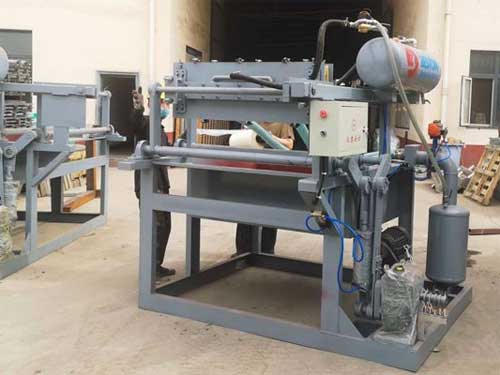Pulp molding is a sustainable packaging process that uses waste paper and other natural fibers to create various products, such as egg trays, fruit trays, and other protective packaging solutions. As a cost-effective and eco-friendly alternative to plastic packaging, pulp molding has gained popularity among businesses worldwide.
However, to ensure the efficiency and longevity of pulp molding equipment, regular maintenance and replacement of spare parts are necessary. In this article, we will discuss the significance of maintaining and repairing pulp molding equipment for optimum performance, and the importance of spare parts in achieving this goal.
Importance of Maintaining Pulp Molding Equipment
Ensuring Consistent Quality and Production Efficiency
Proper maintenance of pulp molding equipment is crucial to ensure consistent product quality and production efficiency. By regularly inspecting and cleaning the machines, operators can identify and address issues before they lead to costly downtime or inferior product quality.
Prolonging the Lifespan of the Equipment
Maintenance and repair also extend the lifespan of pulp molding equipment. By replacing worn-out parts and fixing damaged components, the machines can operate at their full capacity for an extended period, resulting in greater return on investment for the business.
The Role of Spare Parts in Pulp Molding Equipment Maintenance
Importance of High-Quality Spare Parts
High-quality spare parts are essential to maintain the performance and efficiency of pulp molding equipment. Inferior quality parts can lead to equipment malfunction, lower product quality, and higher maintenance costs in the long run. Thus, investing in reliable and durable spare parts is crucial for the smooth operation of the machines.
Types of Pulp Molding Equipment Spare Parts
There are various types of spare parts used in pulp molding equipment, including molds, platens, transfer arms, vacuum pumps, and more. Each of these components plays a critical role in the molding process, and regular maintenance and replacement of these parts are necessary to ensure consistent product quality and production efficiency.
In the following sections, we will discuss the various pulp molding equipment spare parts in more detail and their significance in the maintenance and repair of pulp molding machines.
Common Spare Parts for Pulp Molding Equipment
Pulp molding equipment is made up of several components that work together to form the final product. Over time, these components may wear out and require replacement to ensure the efficient functioning of the equipment. Here are some of the most commonly replaced spare parts in pulp molding equipment.
Most Commonly Replaced Spare Parts
- Molds: Pulp molds are the key components of pulp molding machines, and they can experience wear and tear due to the high pressure and heat during the molding process. As such, it is essential to inspect molds regularly and replace them when necessary to maintain product quality and ensure optimal production.
- Platens: Platens provide support for the molds during the molding process. Due to the high pressure and temperature involved, platens can warp or become damaged over time, leading to suboptimal product quality. Replacing platens as needed can help prevent such issues.
- Valves: Valves regulate the flow of water and pulp in the pulp molding process. They can become clogged with debris or damaged due to wear and tear, leading to decreased production efficiency and product quality. Replacing valves can help ensure consistent production quality and improve overall equipment performance.
Importance of Replacing Worn-Out Parts
Replacing worn-out parts is critical to maintaining the optimal performance of pulp molding equipment. Failing to replace damaged parts can lead to reduced production efficiency, lower product quality, and even equipment failure. Here are some reasons why it is essential to replace worn-out parts promptly.
- Prevent Downtime: A broken pulp molding machine can cause downtime, which can lead to a loss of production and revenue. Replacing worn-out parts as soon as possible can help prevent such downtime.
- Maintain Product Quality: Worn-out parts can affect product quality, leading to an increased number of rejected products. Replacing these parts can help maintain product quality and consistency.
- Ensure Operator Safety: Worn-out parts can pose safety hazards to operators working with pulp molding equipment. Replacing these parts can help ensure the safety of operators and prevent workplace accidents.
In conclusion, pulp molding equipment is an essential part of sustainable packaging, and the replacement of worn-out parts is crucial for its optimal functioning. Regular inspection and maintenance of equipment, as well as prompt replacement of damaged parts, can help prevent downtime, maintain product quality, and ensure operator safety.
Maintenance Practices for Pulp Molding Equipment
Maintaining pulp molding equipment is crucial to ensure optimum performance and productivity. Here are some best practices for keeping the equipment in top condition:
Cleaning
Regular cleaning is essential for removing dirt, debris, and other contaminants that can affect the performance of the equipment. Operators should use the recommended cleaning solutions and procedures provided by the manufacturer to ensure the safety of the equipment and workers. It is also important to clean the molds, platens, and other components thoroughly after each production run to avoid any residual contamination.
Lubrication
Lubrication is necessary to ensure the smooth operation of moving parts and reduce wear and tear. The type of lubricant and frequency of application depend on the specific equipment and the manufacturer’s recommendations. Over-lubrication can also be harmful, so it is essential to follow the manufacturer’s guidelines for proper lubrication.
Inspection
Regular inspection of pulp molding equipment is essential to detect any issues early on and prevent more significant problems from occurring. Operators should inspect the molds, platens, valves, and other components for wear, damage, or any signs of malfunction. Any issues should be addressed immediately to avoid production downtime and ensure product quality.
Regular maintenance practices, such as cleaning, lubrication, and inspection, can prolong the lifespan of pulp molding equipment and improve production efficiency. By taking the necessary steps to maintain and repair the equipment, businesses can save on maintenance costs and avoid unnecessary downtime.
